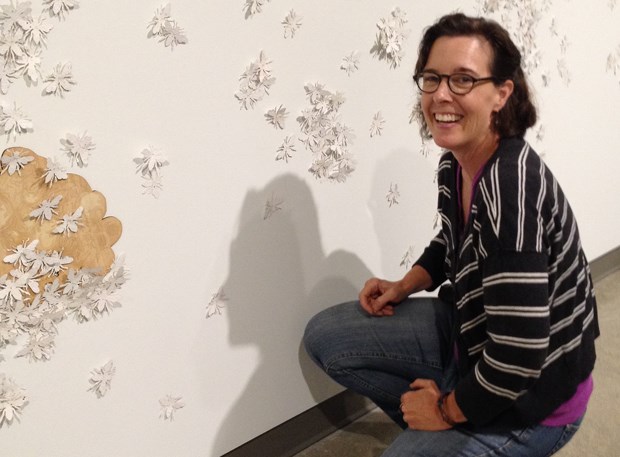|
Thanks to a small army of volunteers with watering cans in tow, and a good neighbour who allowed access to their garden hose, portions of a bee-friendly pasture thrived during this summer’s heat wave. |
And now, an art installation at the Richmond Art Gallery will be helping spread the word about developing other pollinator supportive habitats.
Cameron Cartiere, an associate professor at Emily Carr University of Art and Design, was the driving force behind the establishment this spring of the Bath Slough Pollinator Project that had a 1,000-foot-long by 71-foot-wide neglected BC Hydro right of way in east Richmond transformed into flowering pasture which was designed to help support flagging bee populations in the area.
Faced with drought-like conditions through much of the summer, Cartiere said volunteers hand-watered a small stand of sunflowers at the west end of the
pasture during the summer which had been grown and planted by students from Cambie secondary.
Due to Lower Mainland wide watering restrictions, the rest of the pasture was dependent on rain water. But because the seeds were planted early in the season, they grew and thrived all the way through mid-July.
"Then, just like all the other green spaces across the city, it faded with the lack of rain," Cartiere said. "However, even as it browned, it provided food for bees and continued
to improve the soil for next year's planting."
The pasture was monitored daily for bee activity and their numbers counted. That data will act as a baseline for next summer’s flower planting to see if the efforts have resulted in an increase of pollinators.
Cartiere said the addition of two “bee hotels” should also help attract the insects to the area.
And now that the growing season is coming to a close, Cartiere’s art installation, called For All is For Yourself, which officially opens today (Sept. 18) is designed to help spread the message about the importance of pollinators in the food chain, and how fragile some populations have become due in part to habitat destruction and pesticide use.
Cartiere’s piece covers a large expanse of wall space in the gallery and features 10,001 western bumble bees made from laser cut, recycled paper — produced by a large group of volunteers — that has been embedded with bee-friendly flower seeds (yellow alyssum, which is also known as basket of gold).
The bees are individually pinned to the wall like those found in specimen collections, while sheets of sustainable birch wood have been fashioned into a background of bumble bee nests to emphasize that the endangered insect lives in small colonies of around 400, compared to honeybees which can number in the thousands.
Near the conclusion of the art show’s run, a portion of Carteire’s bees will be offered to the public as a memento that can be planted in a garden to help attract pollinators.
“The remaining half of the swarm will be taken up to Kelowna where there is another pollinator project. And the colony of paper bees will be rebuilt with some more recycled, seed paper,” she said.
Next spring the Bath Slough pasture will be planted with flowers in the shape of bumble bee wings.
“It will look like stained glass,” Cartiere said.“And the best thing is that the pasture is on YVR’s flight path, so people flying over top will be able to look down and see this wonderful sight.”
For All Is For Yourself is being shown alongside another art project, featuring several hundred printed silk tissue sheets to create a “bee carpet” colony of 30,000 individual bees swirling among patterned flora and mythical personages that reference the symbiotic relationship of bees to flowers.
The exhibitions run until Jan. 3, 2016.



